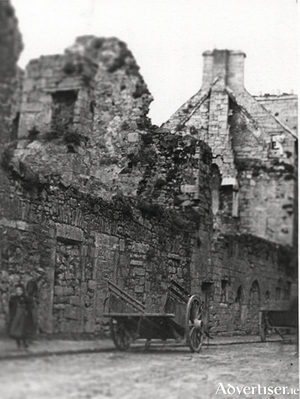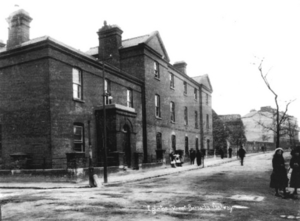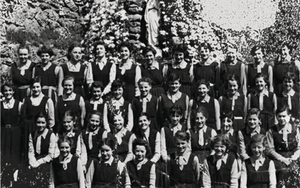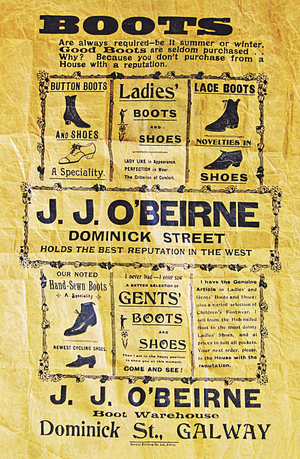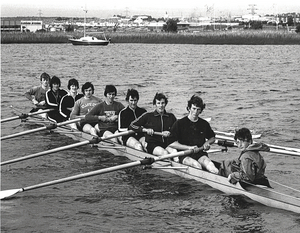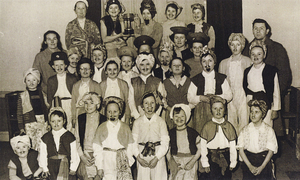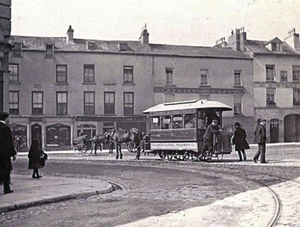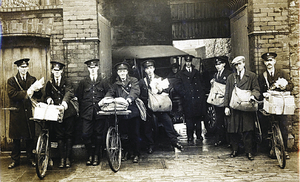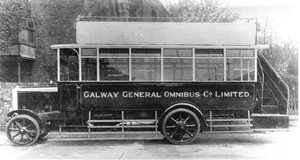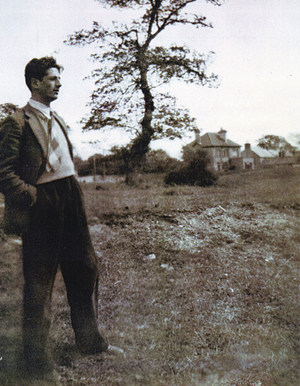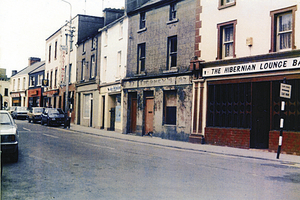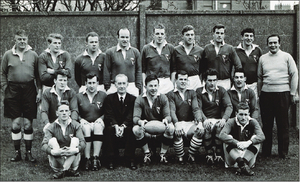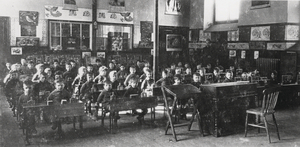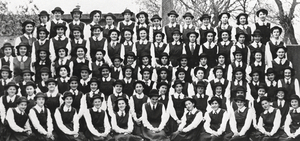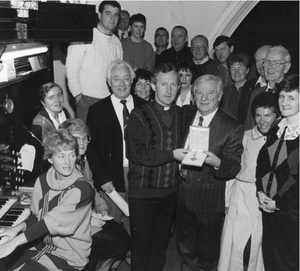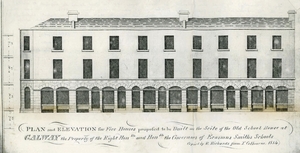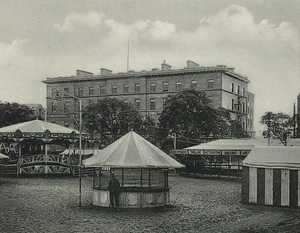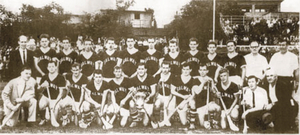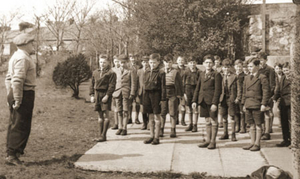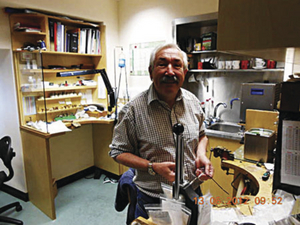The Augustinian nunnery
Thu, Apr 09, 2015
The Augustinian Friars have been in Galway since 1508 when Margaret Athy, whose husband was mayor at the time, built a friary at Forthill, near a spring called St Augustine’s Well, the waters whereof wrought miraculous cures. In O’Flaherty’s Iar-Chonnacht, there is reproduced a document in which a miraculous cure is attested to by the signatures of several witnesses.
Read more ...The Barracks, Eglinton Street
Thu, Apr 02, 2015
In 1640, on the site of this barracks, there was a three storey slated house to the front, and a one storey thatched house to the back. It was owned by Oliver Dean, an Irish papist. In 1657 it was owned by John Peters, an English Protestant, and was called Peter’s Plot.
Read more ...The Presentation Sisters, 200 years in Galway
Thu, Mar 26, 2015
In 1815, the warden of Galway Dr French went to Kilkenny to ask sisters of the Presentation Order to return with him to Galway to found a convent here. A Reverend Bartholomew Burke has left a fund of £4,800 for the purpose. Three sisters arrived here in October of that year. They moved into a house in Kirwan’s Lane temporarily, and from there to Eyre Square. On March 25th, 1819, they moved to a house in poor condition that had originally been built as a Charter School and which would become known as the Presentation Convent. The following year they opened their school adjacent to the convent.
Read more ...Cobblers and shoemakers
Thu, Mar 19, 2015
The 1651 map of Galway shows a Shoemaker’s Tower located in what is the Eyre Square Shopping Centre today. Shoemaker’s Lane, or Bóithrín na Sudairí, the road of the shoemakers or the tanners, was where Buttermilk Walk is today. Shoemaking was always an important business but the individual shoemaker is a rare breed now, instead you associate the craft with factories like Dubarry in Ballinasloe.
Read more ...The Head of the River
Thu, Mar 12, 2015
In 1976 a group of likeminded people got together to work out a way to make the sport of rowing in Galway more competitive. They decided the best way to achieve this was to set up a new club, and so Tribesmen Rowing Club was formed. Starting a new rowing club is an expensive business so they began a number of fundraising activities, running raffles, organising dances, etc. They managed to get their first crew on the water in 1977.
Read more ...Remembering Máire Stafford
Thu, Mar 05, 2015
Máire and Seán Stafford were a touchstone of Irish language culture in this city for more than 60 years. They each had many and different talents and, when they were together, they made a formidable team. They were always together. It took him a whole three weeks after he met her to ask her to marry him. They kept Conradh na Gaeilge going for years, they kept Feis Ceoil an Iarthar going for years, they kept Féile Drámaíochta na Scoil going for years, they were the mainstay of An Taibhdhearc from 1950 for many years, their contribution to the quality of life in Galway was immense. They also reared a very talented family, many of whom were on the stage for the first time while still in their mother’s womb.
Read more ...The winter tram
Thu, Feb 26, 2015
This photograph of a single-deck horse drawn tram was taken in Eyre Square c1900. The American style dome roof top cover provided cover for passengers during the winter. In one of their books, Somerville and Ross described these vehicles thus: “The little one-horse trams glide along the shining desolate road like white-backed beetles.” This tram was painted in a battleship grey colour. The double-deck open summer trams, which needed two horses to pull them, were painted in olive-green and white.
Read more ...Post office communications
Thu, Feb 19, 2015
This photograph of a group of postmen was taken on December 17 1928 outside the General Post Office in Eglinton Street. The sorting office was inside the double gate, as was the long narrow passage that brought one into the back of the post office. The car in the background was a Model T. Notice the cobbled footpath.
Read more ...The Galway General Omnibus Company
Thu, Feb 12, 2015
Our photograph today shows a Karrier double-decker bus which was operated by the Galway General Omnibus Company. It was taken at the Spring Show in the RDS in 1924, before it went into revenue earning service. The side panel carries the name of the company, but not the crest. The small lettering on the chassis below the word ‘Galway’ reads ’12 m.p.h.’ A major problem with this type of vehicle was its chain drive which frequently slipped off and caused breakdowns. The bus had solid-tyred wheels and was uncomfortable to ride in.
Read more ...Memories of Shantalla Place
Thu, Feb 05, 2015
Shantalla Place was a little development of 23 houses which were built by a man named Birmingham, Nos 1 to 6 are on the Rahoon Road, and Nos 7 to 23 form a terrace just off that road. Originally, it was called Birmingham Terrace, later Sycamore Drive, before they finally settled on Shantalla Place. Mothers on this terrace used to warn their children not ‘to go down to the scheme’ when the rest of Shantalla was being built.
Read more ...William Street West c1978
Thu, Jan 29, 2015
William of Orange had a major impact on the history of this city, so I presume it was after him that three streets in Galway were named, Williamsgate Street, William Street, and the one in our photograph, William Street West.
Read more ...One hundred and thirty years of Connacht Rugby
Thu, Jan 22, 2015
The Connacht branch of the Irish Rugby Football Union was formed on December 8, 1885 in Corless’ Burlington Dining Rooms, Andrew Street, and Church Lane, Dublin. The meeting took place after the first time Connacht played as a province in a match against Leinster. The clubs represented at the meeting were Ballinasloe, Castlebar, Galway Grammar School, Galway Town, Queen’s College Galway, and Ranelagh School, Athlone.
Read more ...The Patrician Brothers in Galway
Thu, Jan 15, 2015
On this day, January 15 in the year 1827, the Patrician Brothers arrived in Galway for the first time. Brothers Paul O’Connor and James Walsh took up residence in the Charity Free School in Lombard Street. Three hundred boys attended that day. This school for the poor was originally founded in 1790 in Back Street (now St Augustine Street). In 1824 it transferred to the Lombard Street barracks which had been built in 1749, and purchased from the government by Warden French in 1823. It had been a struggle to keep the school going so the Patricians were invited to take it over and manage it. The barracks formed three sides of a square, the Brothers lived in one wing and the school occupied another. It had one large room on the ground floor and one large room overhead.
Read more ...Calling all ‘Pres’ past pupils
Thu, Jan 08, 2015
Two hundred years ago (on October 27 1815) the first Presentation Sisters came to Galway and founded the first Catholic schools for girls in the city. They moved in to Kirwan’s Lane, then to Eyre Square for three years, before settling into a vacant house in the suburbs, which has been known as the Presentation Convent ever since.
Read more ...Memories of Sonny Molloy
Tue, Dec 23, 2014
Sonny (whose real name was Joseph) was born 89 years ago, one of six children to Patrick and Mary Molloy of St Brendan’s Road in Woodquay. He went to the ‘Mon’ where he learned to play football among other things. A match report in a local paper once carried the headline “Five Goal Molloy”, a fact which he managed to drop into conversation many times over the years. Chatting with him could be unnerving as he laced his chat with colourful sayings like “Long drawers”, “Bring up the bucket”, “Th’oul suit turned well”, ’44 short’, “I hate small men”, and of course his famous draper’s mantra, “We have your size”.
Read more ...High Street facades
Thu, Dec 18, 2014
Galway Grammar School was founded by Erasmus Smith about 1667 in a temporary premises and it moved to High Street about 1684. An entry in the records for January 22 1684 reads: “That Dr. John Coghill be desired to write unto Mr. Patrick Mains in Gallaway that he will more particularly inspect the house there belonging unto Sir Robert Ward concerning the necessary repairs to make it convenient for a school and a commodious dwelling for the schoolmaster and usher and for boarders lodgings that it will amount to.”
Read more ...A postcard of Toft’s Amusements
Thu, Dec 11, 2014
The Toft family were associated with Eyre Square for many years since 1883 when they first brought a carnival there.
Read more ...Galway three-in-a row teams
Thu, Dec 04, 2014
The Galway senior football team played in four All-Ireland finals in a row from 1963 to 1966. They lost the first one to Dublin but achieved a magnificent three in a row in 1964, 1965, and 1966. They were not the only Galway team to do so as the New York Galway senior hurling team managed a similar treble, winning the New York Championship in 1964, ‘65, and ’66.
Read more ...Calling all Jes past pupils
Thu, Nov 27, 2014
Like most national schools in the 1950s, the bunscoil in Coláiste Iognáid (the Jes) used to have a little break, known as a ‘sos’, mid morning. The lowest class in the Jes was Bun Rang II and they had a charismatic teacher named Power, who was known only as ‘An Paorach’. This man was a Gaeilgeóir who taught everything through Irish, but made it fun. You had to learn songs like ‘Beidh Aonach Amárach i gContae an Chláir’ or ‘Trasna na dTonnta dul siar, dul siar’. Weather permitting he would use the period of the ‘sos’ to take his pupils out drilling around the pitch, always carrying a whistle and issuing his commands in Irish.
Read more ...Hartmann’s of Galway
Thu, Nov 20, 2014
The first member of the Hartmann family to arrive in Galway was Alphons. His older brother Joseph was already established in business in Limerick. Joseph went back to Triburg in the Black Forest in Germany in 1895 to get married, and when he and his bride were about to return to Ireland, his father asked him if he would take Alphons with him.
Read more ...